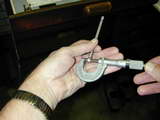A Bench Stand for Micrometers
Created: May 2007
There are times when a third hand would be really handy. One of those times is when trying to accurately "mike" a bore gauge. Unless the rounded ends of the telescoping T arms are in line with the axis of the micrometer anvils, the reading will be wrong. Sure, the error will be small, but as this operation is used to measure cylinder bores on engines where tenths of a thou are significant, errors are unacceptable. The solution is a stand to hold the micrometer leaving one hand free to align the gauge while the other turns the screw.
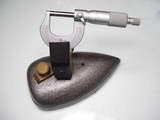 |
 |
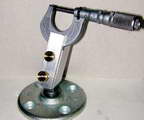 |
These photos show three different implementations of a single concept that dates back to a design by "DUPLEX" that appeared in the Model Engineer in 1950. The versions shown above were made, from left to right, by Charlie Stone (AUS), Ron Chernich (AUS), and Roger Schroeder (USA). Of the three, my own version (center) is faithful to the original design. The other two exhibit the ways smart model engineers adapt a basic design to what they have to hand. First, let's consider the original design.
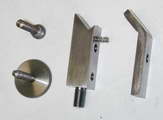 Ian Bradley, or perhaps Norman Fellows, adapted the concept used by a product from the instrument maker, Starrett, as the commercial item had become unavailable. The clamp is based on the concept of the "engineers' clamp" that uses two screws to ensure parallel closure of the jaws. The angle of the head on the Starrett job could be adjusted, but the DUPLEX team decided that 45° was a good angle for reading, and sensibly omitted the angle adjustor. The photo shows the components. The small knurled screw adjusts the jaw gap so that a light turn of the large knob closes the jaws accurately on the frame of the micrometer. The spring opens the jaws when screw pressure is relaxed. Positioning the knobs at the rear gets them out of the way, although this is not critical.
Ian Bradley, or perhaps Norman Fellows, adapted the concept used by a product from the instrument maker, Starrett, as the commercial item had become unavailable. The clamp is based on the concept of the "engineers' clamp" that uses two screws to ensure parallel closure of the jaws. The angle of the head on the Starrett job could be adjusted, but the DUPLEX team decided that 45° was a good angle for reading, and sensibly omitted the angle adjustor. The photo shows the components. The small knurled screw adjusts the jaw gap so that a light turn of the large knob closes the jaws accurately on the frame of the micrometer. The spring opens the jaws when screw pressure is relaxed. Positioning the knobs at the rear gets them out of the way, although this is not critical.
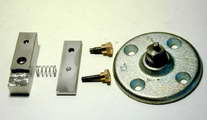 My version of the tool required only a morning to complete, and being extraordinarily pleased with the improvement it provided in workshop productivity, I sent out a photo to the Motor Boys. Less than a week later, Roger Schroeder had completed his own version. I'll come to the base used later, but notice how Roger avoids a lot of hacksawing and milling by mounting the entire body of the clamp at an angle. He also made the release spring concentric with the small clamp adjusting screw. This reduces the amount of drilling and measuring required—something of which I fully approve.
My version of the tool required only a morning to complete, and being extraordinarily pleased with the improvement it provided in workshop productivity, I sent out a photo to the Motor Boys. Less than a week later, Roger Schroeder had completed his own version. I'll come to the base used later, but notice how Roger avoids a lot of hacksawing and milling by mounting the entire body of the clamp at an angle. He also made the release spring concentric with the small clamp adjusting screw. This reduces the amount of drilling and measuring required—something of which I fully approve.
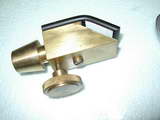 By coincidence, shortly after receiving Roger's photos, I was talking with Charlie Stone who lives in far off Perth, Western Australia (and is no relation to Les Stone
By coincidence, shortly after receiving Roger's photos, I was talking with Charlie Stone who lives in far off Perth, Western Australia (and is no relation to Les Stone  ). Charlie remarked that he'd also built one of these as well, sort-of to the DUPLEX design, and did not know how he'd gotten along before he made it. Like Roger, and base aside again, Charlie has used a simplified clamp that avoids milling. Seems like I'm the only bunny who spent an hour making swarf. Charlie has also used a fixed screw for the parallel adjustment—quite practical if the holder is made to suit a single, known, micrometer.
). Charlie remarked that he'd also built one of these as well, sort-of to the DUPLEX design, and did not know how he'd gotten along before he made it. Like Roger, and base aside again, Charlie has used a simplified clamp that avoids milling. Seems like I'm the only bunny who spent an hour making swarf. Charlie has also used a fixed screw for the parallel adjustment—quite practical if the holder is made to suit a single, known, micrometer.
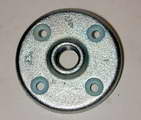 Now to the bases. The device needs a nice, heavy base so it stays put while in use and provides adequate tip-over prevention for the expensive, delicate instrument. For me, the base for the GHT UPT seemed an ideal solution, so a plug that the clamp screws into was turned to fit the UPT base. Roger just visited his local Home Depot and found a suitable cast flange, complete with a screw-in plug! I just love this lateral thinking. If I had not had the UPT base handy, I'd probably have wasted time and money turning one from brass, or cast iron.
Now to the bases. The device needs a nice, heavy base so it stays put while in use and provides adequate tip-over prevention for the expensive, delicate instrument. For me, the base for the GHT UPT seemed an ideal solution, so a plug that the clamp screws into was turned to fit the UPT base. Roger just visited his local Home Depot and found a suitable cast flange, complete with a screw-in plug! I just love this lateral thinking. If I had not had the UPT base handy, I'd probably have wasted time and money turning one from brass, or cast iron.
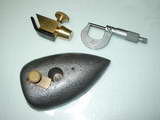 Charlie's stand is even more innovative. Yes, it's the body of a small clothes' iron!! The tapered plug with the finger clamp retainer even allows the same base to hold a variety of workshop gadgets that can be quickly changed without hunting around the shop for the right Allen key, or some other tool. And I'll bet Charlie payed even less for his base than Roger did—and both paid a lot less than me!
Charlie's stand is even more innovative. Yes, it's the body of a small clothes' iron!! The tapered plug with the finger clamp retainer even allows the same base to hold a variety of workshop gadgets that can be quickly changed without hunting around the shop for the right Allen key, or some other tool. And I'll bet Charlie payed even less for his base than Roger did—and both paid a lot less than me!

 Model Engine News Home
Model Engine News Home
This page designed to look best when using anything but IE!
Please submit all questions and comments to
[email protected]
Copyright (c) Ronald A Chernich, 2007. All rights reserved worldwide.
